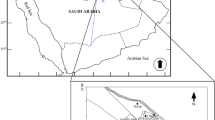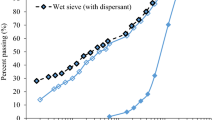Abstract
Magnesia-based refractories (magnesia) are the second most used refractories worldwide and are generally discarded in landfills after their service life even though they are highly expansive when in contact with water. Thus, to ensure the safe disposal of magnesia and to enable the use of landfill areas as future construction sites, it is important to investigate the physical and mechanical behavior of magnesia-containing soil. In this study, the physical properties, swelling characteristics, and undrained shear response of magnesia–sand mixtures at various magnesia contents were measured and compared before and after hydration. After hydration, the behavior of the magnesia changed from a sand-like behavior to a clay-like behavior, where the change in behavior was accompanied with a reduction in the particle size and an increase plasticity. In addition, the swelling strain (SS) and swelling pressure of the magnesia-sand mixtures increased with an increase in the magnesia content in the mixture, showing high expansivity (SS > 25%) compared to that of natural expansive soil. Before hydration, the magnesia content had no significant effect on the average normalized peak shear strength (Su/σ′c = peak shear strength/confining pressure) of the magnesia–sand mixture. However, after hydration, the average Su/σ′c of magnesia–sand mixture decreased with an increase in the magnesia content. Particularly, the average Su/σ′c of pure hydrated magnesia was comparable to that of normally consolidated clay.









Similar content being viewed by others
Change history
27 December 2022
A Correction to this paper has been published: https://doi.org/10.1007/s10064-022-03053-8
References
Amaral L, Oliveira I, Bonadia P, Salomão R, Pandolfelli VC (2011) Chelants to inhibit magnesia (MgO) hydration. Ceram Int 37(5):1537–1542. https://doi.org/10.1016/j.ceramint.2011.01.030
Amaral L, Oliveira I, Salomão R, Frollini E, Pandolfelli V (2010) Temperature and common-ion effect on magnesium oxide (MgO) hydration. Ceram Int 36(3):1047–1054. https://doi.org/10.1016/j.ceramint.2009.12.009
Arianpour F, Kazemi F, Fard FG (2010) Characterization, microstructure and corrosion behavior of magnesia refractories produced from recycled refractory aggregates. Miner Eng 23(3):273–276. https://doi.org/10.1016/j.mineng.2009.11.001
Belkhatir M, Schanz T, Arab A (2013) Effect of fines content and void ratio on the saturated hydraulic conductivity and undrained shear strength of sand–silt mixtures. Envion Earth Sci 70(6):2469–2479. https://doi.org/10.1007/s12665-013-2289-z
Birchal V, Rocha S , Ciminelli V (2000) The effect of magnesite calcination conditions on magnesia hydration. Miner Eng 13(14–15):1629–1633. https://doi.org/10.1016/S0892-6875(00)00146-1
Canterford (1985) Magnesia—an important industrial mineral: a review of processing options and uses. Miner Process Extra Metall Rev 2(1–2):57–104. https://doi.org/10.1080/08827508508952601
Chen FH (2012) Foundations on expansive soils. Elsevier
Choo H, Burns S (2015) Shear wave velocity of granular mixtures of silica particles as a function of finer fraction, size ratios and void ratios. Granul Mat 17(5):567–578. https://doi.org/10.1007/s10035-015-0580-2
Choo H, Lee W, Lee C (2017) Compressibility and small strain stiffness of kaolin clay mixed with varying amounts of sand. KSCE J Civ Eng 21(6):2152–2161. https://doi.org/10.1007/s12205-016-1787-4
Domínguez M, Romero-Sarria F, Centeno M, Odriozola J (2010) Physicochemical characterization and use of wastes from stainless steel mill. Environ Prog Sustainable Energy 29(4):471–480
Elkady TY, Shaker AA, Dhowain AW (2015) Shear strengths and volume changes of sand–attapulgite clay mixtures. Bull Eng Geol Environ 74(2):595–609. https://doi.org/10.1007/s10064-014-0653-1
Fang H, Smith JD, Peaslee KD (1999) Study of spent refractory waste recycling from metal manufacturers in Missouri. Resour Conserv recycl 25(2):111–124. https://doi.org/10.1016/S0921-3449(98)00059-7
Ferreira G, López-Sabirón AM, Aranda J, Mainar-Toledo M, Aranda-Usón A (2015) Environmental analysis for identifying challenges to recover used reinforced refractories in industrial furnaces. J Clean Prod 88:242–253. https://doi.org/10.1016/j.jclepro.2014.04.087
Holtz WG, Gibbs H (1956) Engineering properties of expansive clays. Trans Am Soc Civ Eng 121(1):641–663
Horckmans L, Nielsen P, Dierckx P, Ducastel A (2019) Recycling of refractory bricks used in basic steelmaking: A review. Resources, Conservation and Recycling 140(297–304
Jin F, Al-Tabbaa A (2014) Characterisation of different commercial reactive magnesia. Adv Cem Res 26(2):101–113. https://doi.org/10.1680/adcr.13.00004
Kayabali K, Demir S (2011) Measurement of swelling pressure: direct method versus indirect methods. Can Geotech J 48(3):354–364. https://doi.org/10.1139/T10-074
Kusiorowski R (2020) MgO-ZrO2 refractory ceramics based on recycled magnesia-carbon bricks. Constr Build Mater 231:117084. https://doi.org/10.1016/j.conbuildmat.2019.117084
Ladd CC, DeGroot DJ (2004) Recommended practice for soft ground site characterization: Arthur Casagrande Lecture, Massachusetts Institute of Technology
Lambe TW, Whitman RV (1969) John Wiley and Sons. Soil mechanics, series in soil engineering
Lashkari A (2016) Prediction of flow liquefaction instability of clean and silty sands. Acta Geotech 11(5):987–1014. https://doi.org/10.1007/s11440-015-0413-9
Liu Y, Vanapalli SK (2017) Influence of lateral swelling pressure on the geotechnical infrastructure in expansive soils. J Geotech Geoenviron 143(6):04017006. https://doi.org/10.1061/(ASCE)GT.1943-5606.0001651
Matabola KP, van der Merwe EM, Strydom CA, Labuschagne FJ (2010) The influence of hydrating agents on the hydration of industrial magnesium oxide. J Chem Tech Biotech 85(12):1569–1574. https://doi.org/10.1002/jctb.2467
Nelson J, Miller DJ (1997) Expansive soils: problems and practice in foundation and pavement engineering. John Wiley & Sons
Park S, Ma J, Yun TS, Jeon S, Byeun Y, Kang D, Jang J (2020) Pore-scale swelling mechanism of magnesium oxide granules during hydration. Constr Build Mater 251:119101. https://doi.org/10.1016/j.conbuildmat.2020.119101
Porcino D, Diano V, Triantafyllidis T, Wichtmann T (2020) Predicting undrained static response of sand with non-plastic fines in terms of equivalent granular state parameter. Acta Geotech 15(4):867–882. https://doi.org/10.1007/s11440-019-00770-5
Prasanna R, Sivathayalan S (2017) Effect of moist tamping water content on the shear strength of soil
Riemer MF (1992) The effects of testing conditions on the constitutive behavior of loose, saturated sands under monotonic loading. University of California, Berkeley
Salomao R, Bittencourt L, Pandolfelli V (2007) A novel approach for magnesia hydration assessment in refractory castables. Ceram Int 33(5):803–810. https://doi.org/10.1016/j.ceramint.2006.01.004
Seed HB, Woodward Jr RJ, Lundgren R (1962) Prediction of swelling potential for compacted clays. J Soil Mech Found Div 88(3):53–87. https://doi.org/10.1061/TACEAT.0008724
Simpson D, Evans T (2016) Behavioral thresholds in mixtures of sand and kaolinite clay. J Geotech Geoenviron 142(2):04015073. https://doi.org/10.1061/(ASCE)GT.1943-5606.0001391
Skempton A (1957) Discussion of The planning and design of the new Hong Kong Air Port 305–307
Smith JD, Fang H, Peaslee KD (1999) Characterization and recycling of spent refractory wastes from metal manufacturers in Missouri. Resour Conserv Recycl 25(2):151–169
Sridharan A, Prakash K (2000) Classification procedures for expansive soils. Proc Inst Civ Eng Geotech Eng 143(4):235–240. https://doi.org/10.1680/geng.2000.143.4.235
Strydom C, Van der Merwe E, Aphane M (2005) The effect of calcining conditions on the rehydration of dead burnt magnesium oxide using magnesium acetate as a hydrating agent. J Therm Anal Calorim 80(3):659–662. https://doi.org/10.1007/s10973-005-0710-x
Tang X, Guo L, Liu Q, Li Y, Li T, Zhu Y (2015) Morphology analysis of magnesium hydroxide prepared by magnesium oxide hydration within seawater. Cryst Res Technol 50(3):203–209. https://doi.org/10.1002/crat.201400122
Terzaghi K (1943) Theoretical soil mechanics. John Wiley and Sons. New York 11–15
Thevanayagam S, Mohan S (2000) Intergranular state variables and stress–strain behaviour of silty sands. Geotechnique 50(1):1–23. https://doi.org/10.1680/geot.2000.50.1.1
Thevanayagam S, Shenthan T, Mohan S, Liang J (2002) Undrained fragility of clean sands, silty sands, and sandy silts. J Geotech Geoenviron 128(10):849–859. https://doi.org/10.1061/(ASCE)1090-0241(2002)128:10(849)
Vallejo LE, Mawby R (2000) Porosity influence on the shear strength of granular material–clay mixtures. Eng Geol 58(2):125–136. https://doi.org/10.1016/S0013-7952(00)00051-X
Van der Merwe E, Strydom C, Botha A (2004) Hydration of medium reactive industrial magnesium oxide with magnesium acetate. J Therm Anal Calorim 77(1):49–56
Wroth C, Houlsby G (1985) Soil mechanics-property characterization and analysis procedures
Xing Z, Bai L, Ma Y, Wang D, Li M (2018) Mechanism of magnesium oxide hydration based on the multi-rate model. Materials 11(10):1835. https://doi.org/10.3390/ma11101835
Yal GP, Akgün H (2013) Landfill site selection and landfill liner design for Ankara. Turkey Envion Earth Sci 70(6):2729–2752
Yang S, Lacasse S, Sandven R (2006) Determination of the transitional fines content of mixtures of sand and non-plastic fines. Geotech Test J 29(2):102–107. https://doi.org/10.1520/GTJ14010
Funding
This research was supported by research funds from the Korean Society of Civil Engineers and by the National Research Foundation of Korea (NRF) (2018R1A2B6000973).
Author information
Authors and Affiliations
Corresponding author
Additional information
The original online version of this article was revised: The above article was published with error in author name. Jihwan Lee is the correct name instead of Jiwhan Lee. This is now updated here.
Rights and permissions
Springer Nature or its licensor (e.g. a society or other partner) holds exclusive rights to this article under a publishing agreement with the author(s) or other rightsholder(s); author self-archiving of the accepted manuscript version of this article is solely governed by the terms of such publishing agreement and applicable law.
About this article
Cite this article
Yoon, B., Lee, J., Choo, H. et al. Swelling and behavioral transformation of magnesia-sand mixtures: experimental characterization of physical properties and undrained shear strength. Bull Eng Geol Environ 81, 46 (2022). https://doi.org/10.1007/s10064-021-02547-1
Received:
Accepted:
Published:
DOI: https://doi.org/10.1007/s10064-021-02547-1




